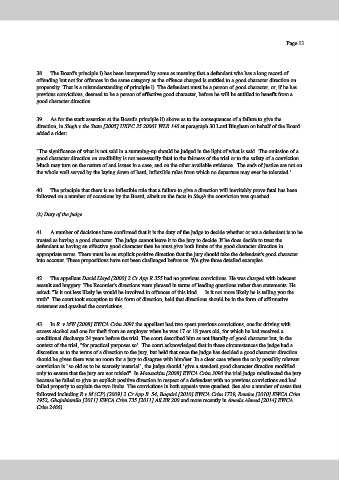Page 421 - Magistrates Conference 2019
P. 421
Page 13
38. The Board's principle i) has been interpreted by some as meaning that a defendant who has a long record of
offending but not for offences in the same category as the offence charged is entitled to a good character direction on
propensity. That is a misunderstanding of principle i). The defendant must be a person of good character, or, if he has
previous convictions, deemed to be a person of effective good character, before he will be entitled to benefit from a
good character direction.
39. As for the stark assertion at the Board's principle ii) above as to the consequences of a failure to give the
direction, in Singh v the State [2005] UKPC 35 20061 WLR 146 at paragraph 30 Lord Bingham on behalf of the Board
added a rider:
"The significance of what is not said in a summing-up should be judged in the light of what is said. The omission of a
good character direction on credibility is not necessarily fatal to the fairness of the trial or to the safety of a conviction.
Much may turn on the nature of and issues in a case, and on the other available evidence. The ends of justice are not on
the whole well served by the laying down of hard, inflexible rules from which no departure may ever be tolerated."
40. The principle that there is no inflexible rule that a failure to give a direction will inevitably prove fatal has been
followed on a number of occasions by the Board, albeit on the facts in Singh the conviction was quashed.
(k) Duty of the judge
41. A number of decisions have confirmed that it is the duty of the judge to decide whether or not a defendant is to be
treated as having a good character. The judge cannot leave it to the jury to decide. If he does decide to treat the
defendant as having an effective good character then he must give both limbs of the good character direction in
appropriate terms. There must be an explicit positive direction that the jury should take the defendant's good character
into account. These propositions have not been challenged before us. We give three detailed examples.
42. The appellant David Lloyd [2000] 2 Cr App R 355 had no previous convictions. He was charged with indecent
assault and buggery. The Recorder's directions were phrased in terms of leading questions rather than statements. He
asked: "Is it not less likely he would be involved in offences of this kind. ... Is it not more likely he is telling you the
truth". The court took exception to this form of direction, held that directions should be in the form of affirmative
statement and quashed the convictions.
43. In R. v MW [2008] EWCA Crim 3091 the appellant had two spent previous convictions, one for driving with
excess alcohol and one for theft from an employer when he was 17 or 18 years old, for which he had received a
conditional discharge 24 years before the trial. The court described him as not literally of good character but, in the
context of the trial, "for practical purposes so". The court acknowledged that in these circumstances the judge had a
discretion as to the terms of a direction to the jury, but held that once the judge has decided a good character direction
should be given there was no room for a jury to disagree with him/her. In a clear case where the only possibly relevant
conviction is "so old as to be scarcely material", the judge should "give a standard good character direction modified
only to ensure that the jury are not misled". In Moustakim [2008] EWCA Crim 3096 the trial judge misdirected the jury
because he failed to give an explicit positive direction in respect of a defendant with no previous convictions and had
failed properly to explain the two limbs. The convictions in both appeals were quashed. See also a number of cases that
followed including R v M (CP) [2009] 2 Cr.App.R. 54, Baquiri [2010] EWCA Crim 1729, Remice [2010] EWCA Crim
1952, Gbajabiamila [2011] EWCA Crim 735 [2011] All ER 200 and more recently in Aneela Ahmed [2014] EWCA
Crim 2466).

